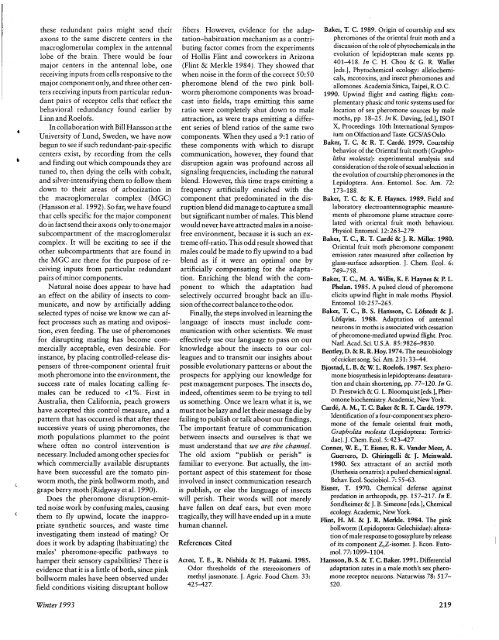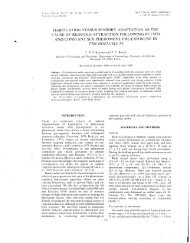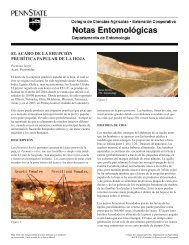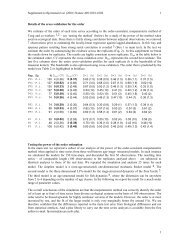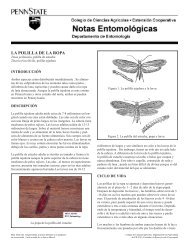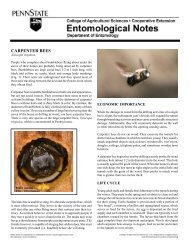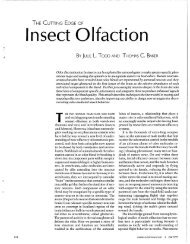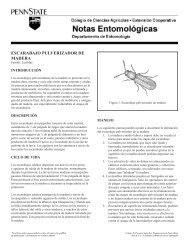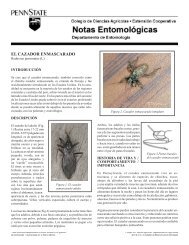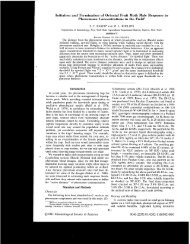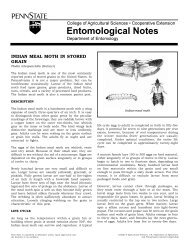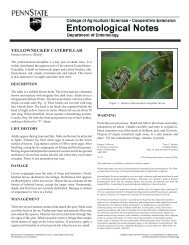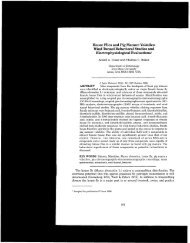Learning the Language of Insects- and How to Talk Back - Entomology
Learning the Language of Insects- and How to Talk Back - Entomology
Learning the Language of Insects- and How to Talk Back - Entomology
You also want an ePaper? Increase the reach of your titles
YUMPU automatically turns print PDFs into web optimized ePapers that Google loves.
<strong>the</strong>se redundant pairs mght send <strong>the</strong>iraxons <strong>to</strong> <strong>the</strong> same discrete centers in <strong>the</strong>macroglomer ular complex in <strong>the</strong> antennallobe <strong>of</strong> <strong>the</strong> brain There would be fourmajor centers in <strong>the</strong> antennal lobe7 onereceiving inputs from cells responsive <strong>to</strong> <strong>the</strong>major component only7 <strong>and</strong> three o<strong>the</strong>r centersreceiving Inputs from particular redundantpairs <strong>of</strong> recep<strong>to</strong>r cells that reflect <strong>the</strong>behavioral redundancy found earlier byLinn <strong>and</strong> Roe10fs~In collaboration with Bill Hansson at <strong>the</strong>4University <strong>of</strong> Lund7 Sweden7 we have nowbegun <strong>to</strong> see if such redundant-pair-specificcenters exist7 by recording from <strong>the</strong> cells' <strong>and</strong> finding out which compounds <strong>the</strong>y aretuned <strong>to</strong>, <strong>the</strong>n dying <strong>the</strong> cells with cobalt,(<strong>and</strong> s~lver-intensifying <strong>the</strong>m <strong>to</strong> follow <strong>the</strong>mdown <strong>to</strong> <strong>the</strong>ir areas <strong>of</strong> arborization in<strong>the</strong> macrog~omerular complex (MGC)(Hansson et a1 1992) So far7 we have foundthat cells specific for <strong>the</strong> major componentdo in fact send <strong>the</strong>ir axons only <strong>to</strong> onemajorsubcompartment <strong>of</strong> <strong>the</strong> macroglomerularcomplex It will be exciting <strong>to</strong> see if <strong>the</strong>o<strong>the</strong>r subcompartments that are found in<strong>the</strong> MGC are <strong>the</strong>re for <strong>the</strong> purpose <strong>of</strong> receivlnginputs from par ticular redundantpairs <strong>of</strong> minor components.Natural noise does appear <strong>to</strong> have hadan effect on <strong>the</strong> ability <strong>of</strong> insects <strong>to</strong> communicate><strong>and</strong> now by artificially addingselected types <strong>of</strong> noise we know we can affectplocesses such as mating <strong>and</strong> oviposition?even feeding The use <strong>of</strong> pheromonesfor disrupting mating has become commerciallyacceptable? even desirable Forinstance, by placing controlled-release dispensers<strong>of</strong> three-component oriental fruitmoth pheromone in<strong>to</strong> <strong>the</strong> environment> <strong>the</strong>success rate <strong>of</strong> males locating calling femalescan be reduced <strong>to</strong> <strong>the</strong>n California> peach growershave accepted this control measure> <strong>and</strong> apattern that has occurred is that after threesuccessive years <strong>of</strong> using pheromones, <strong>the</strong>moth populations plummet <strong>to</strong> <strong>the</strong> pointwhere <strong>of</strong>ten no control intervention isnecessar ye Included among o<strong>the</strong>r species forwhich commercially available disruptantshave been successful are <strong>the</strong> <strong>to</strong>ma<strong>to</strong> pinwoImmoth7 <strong>the</strong> pink bollworm moth7 <strong>and</strong>grape berr y moth (Rldgway et a1 1990).Does <strong>the</strong> pheromone disruption-emittednoise work by confusing males? causing<strong>the</strong>m <strong>to</strong> fly upwind7 locate <strong>the</strong> inappropriatesyn<strong>the</strong>tic sources, <strong>and</strong> waste timeinvestigating <strong>the</strong>m instead <strong>of</strong> mating? Ordoes it work by adapting (habituating) <strong>the</strong>males' pheromone-specific pathways <strong>to</strong>hampe~ <strong>the</strong>ir sensory capabilities? There isevidence that it is a little <strong>of</strong> both, since pinkbollworm males have been observed underfield conditions visiting disruptant hollowWinter 1993fibers <strong>How</strong>ever> evidence for <strong>the</strong> adaptation-habituationmechanism as a contributingfac<strong>to</strong>r comes from <strong>the</strong> experiments<strong>of</strong> Hollis Flint <strong>and</strong> coworkers in Arizona(Flint & Merkle 1984) They showed thatwhen noise in <strong>the</strong> form <strong>of</strong> <strong>the</strong> correct SO: SOpheromone blend <strong>of</strong> <strong>the</strong> two pink bollwormpheromone components was broadcastin<strong>to</strong> fields7 traps emitting this sameratio were completely shut down <strong>to</strong> maleattraction, as were traps emitting a differentseries <strong>of</strong> blend ratios <strong>of</strong> <strong>the</strong> same twocomponents When <strong>the</strong>y used a 9:l ratio <strong>of</strong><strong>the</strong>se components with which <strong>to</strong> disruptcommunication7 however, <strong>the</strong>y found thatdisruption again was pr<strong>of</strong>ound across allsignaling frequencies, including <strong>the</strong> naturalblend <strong>How</strong>ever, this time traps emitting afrequency artificially enriched with <strong>the</strong>component that predominated in <strong>the</strong> disruptionblend did manage <strong>to</strong> capture a smallbut significant number <strong>of</strong> males., This blendwould never have attracted males in a noisefreeenvironment7 because it is such an extreme<strong>of</strong>f-ratio. This odd result showed thatmales could be made <strong>to</strong> fly upwind <strong>to</strong> a badblend as if it were an optimal one byartificially compensating for <strong>the</strong> adaptationEnriching <strong>the</strong> blend with <strong>the</strong> component<strong>to</strong> which <strong>the</strong> adaptation hadselectively occurred brought back an illusion<strong>of</strong> <strong>the</strong> correct balance <strong>to</strong> <strong>the</strong> odor"Finally> <strong>the</strong> steps involved in learning <strong>the</strong>language <strong>of</strong> insects must include communicationwith o<strong>the</strong>r scientists We musteffectively use our language <strong>to</strong> pass on ourknowledge about <strong>the</strong> insects <strong>to</strong> our colleagues<strong>and</strong> <strong>to</strong> transmit our insights aboutpossible evolutionar y patterns or about <strong>the</strong>prospects for applying our knowledge forpest management purposes. The insects do7indeed, <strong>of</strong>tentimes seem <strong>to</strong> be trying <strong>to</strong> tellus something, Once we learn what it is7 wemust not be lazy <strong>and</strong> let <strong>the</strong>ir message die byfailing <strong>to</strong> publish or talk about our findings.The important feature <strong>of</strong> communicationbetween insects <strong>and</strong> ourselves is that wemust underst<strong>and</strong> that we are <strong>the</strong> channel,,The old axiom "publish or perish" isfamiliar <strong>to</strong> everyone,, But actually7 <strong>the</strong> importantaspect <strong>of</strong> this statement for thoseinvolved in insect communication researchis publish, or else <strong>the</strong> language <strong>of</strong> insectswill perish,, Their words will not merelyhave fallen on deaf ears7 but even moretragically, <strong>the</strong>y will have ended up in a mutehuman channel.References CitedAcree, T. E , R. Nishida & H. Fukami. 1985.Odor thresholds <strong>of</strong> <strong>the</strong> stereoisomers <strong>of</strong>methyl jasmonate J Agric Food Chem 33:425427Baker, T,, C. 1989,, Origin <strong>of</strong> courtship <strong>and</strong> sexpheromones <strong>of</strong> <strong>the</strong> oriental fruit moth <strong>and</strong> adiscussion <strong>of</strong> <strong>the</strong> role <strong>of</strong> phy<strong>to</strong>chemicals in <strong>the</strong>evolution <strong>of</strong> lepidopteran male scents pp,401418, In C,, H, Chou & G,, R, Waller[eds,], Phy<strong>to</strong>chemical ecology: allelochemicals,mco<strong>to</strong>xins, <strong>and</strong> insect pheromones <strong>and</strong>allomones, Academia Sinica, Taipei, R, O,,C,1990,, Upwind flight <strong>and</strong> casting flighc complementaryphasic <strong>and</strong> <strong>to</strong>nic systems used forlocation <strong>of</strong> sex pheromone sources by malemoths, pp 18-25, In K, D~ving, led,,], IS01X, Proceedings 10th International Symposiumon Olfaction <strong>and</strong> Taste, GCSIAS Oslo,Baker, T. C. & R" T" Cadi. 1979, Courtshipbehavior <strong>of</strong> <strong>the</strong> Oriental fruit moth (Grapholithamolesta): experimental analysis <strong>and</strong>consideration <strong>of</strong> <strong>the</strong> role <strong>of</strong> sexual selection in<strong>the</strong> evolution <strong>of</strong> courtship pheromones in <strong>the</strong>Lepidoptera, Ann, En<strong>to</strong>mol, Soc, Am, 72:173-188,Baker, T. C. & K. F. Haynes. 1989. Field <strong>and</strong>labora<strong>to</strong>ry electroantennographic measurements<strong>of</strong> pheromone plume structure correlatedwith oxiental fruit moth behaviour,,Physiol En<strong>to</strong>mol, 12: 263-2 79,,Baker, T. C", R., T., Cadi & ,J,. R. Miller:. 1980.Oriental fruit moth pheromone componentemission rates measured after collection byglass-surface adsorption, J, Chem, Ecol,. 6:749-758,Baker, T. C.> M,, A. W~llis, K. F. Haynes & I? L,,Phelan, 1985. A pulsed cloud <strong>of</strong> pheromoneelicits upwind flight in male moths, Physiol,En<strong>to</strong>mol 10: 257-265,Baker, T. C.,, B, S. Hansson, C. L<strong>of</strong>stedt & J.L<strong>of</strong>qvist. 1988" Adaptation <strong>of</strong> antennalneurons in moths is associated with cessation<strong>of</strong> pheromone-mediated upwind flight, Proc,Natl, Acad,, Sci, U,S,.A,. 85: 9826-9830,,Bentley, D. & R. R,. Hoy. 1974. The neurobiology<strong>of</strong> cricket song, Sci Am 231: 33-44,Bjostad, L. B. & W, L. Roel<strong>of</strong>s. 1987., Sex pheromonebiosyn<strong>the</strong>sis in lepidopterans: desaturation<strong>and</strong> chain shortening, pp,. 77-120,, In G,,D, Prestwich & G, L, Bloomquist [eds,], Pheromonebiochemistry, Academic, New York.,Card6> A,, M., T. C. Baker & Ro I.Cadi. 1979.Identification <strong>of</strong> a four-component sex pheromone<strong>of</strong> <strong>the</strong> female oriental fruit moth,Grapholita molesta (Lepidoptera: Tortrici-dae),, J,, Chem, Ecol,, 5: 42 3427,Conner7 W. E.,, T" Eisner, R. K. V<strong>and</strong>er Meer, A.Guer~ero, D. Ghuingelli & ,J. Meinwald..1980. Sex attractant <strong>of</strong> an arctiid moth(Ute<strong>the</strong>sia ornatrix): a pulsed chemical signal,.Behav, E~ol,, Sociobiol,, 'E 55-63,Eisner, 1. 1970. Chemical defense againstpredation in arthropods, pp,, 1,57-217,, In E,,Sondheimer & J,, B, Simeone [eds,]? Chemicalecology Academic, New York,,Flint, H. M" & ,J. R. Merkle. 1984. The pinkbollworm (Lepidoptera: Gelechiidae): alteration<strong>of</strong> male response <strong>to</strong> gossyplure by release<strong>of</strong> its component Z,Z-isomer., J,, Econ,, En<strong>to</strong>mol,77: 1099-1104,,Hansson, B. S,, & T. C. Baker. 1991. Differentialadaptation rates in a male moth's sex pheromonerecep<strong>to</strong>r neulons,, Naturwiss '78: 517-520,


